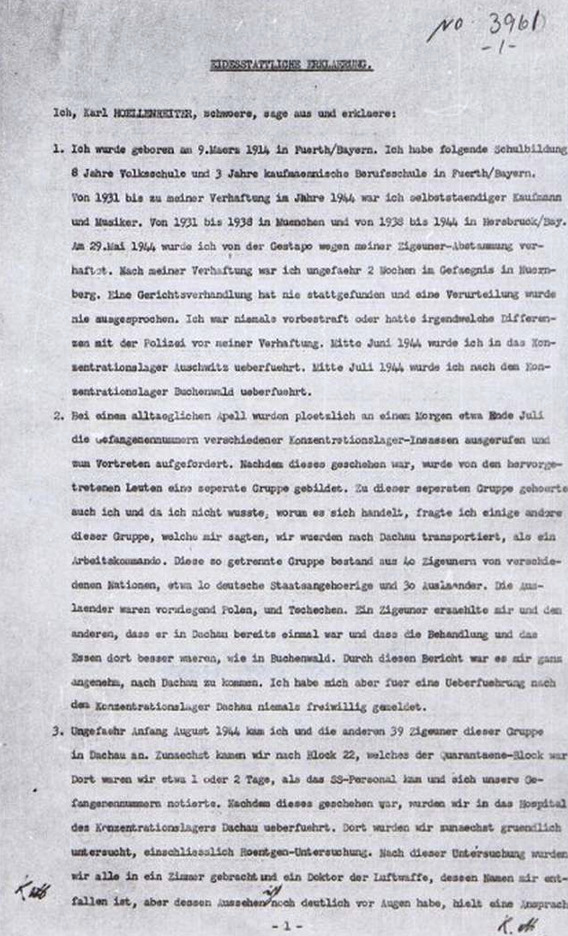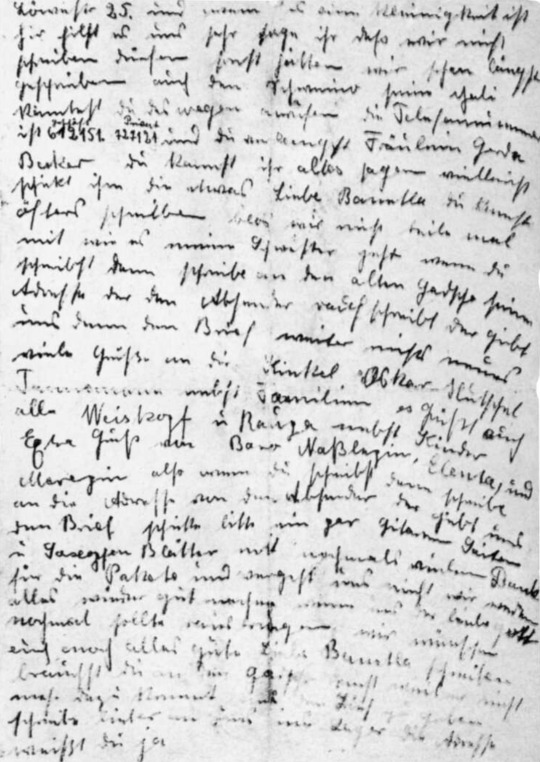#porajmos tw
Text
His fate contrasts with that of another, unrelated, Reinhardt, according to the 102-page study. Anton Reinhardt, a 17 year-old German Gypsy with a Swiss mother, swam the Rhine in 1944 and tried to claim asylum in Switzerland as a conscientious objector. He was expelled and later shot while trying to escape from a Nazi concentration camp.
#romani#roma#switzerland#schweiz#suisse#svizzera#articles#holocaust remembrance day#porajmos tw#samudaripen tw#holocaust
41 notes
·
View notes
Text
a bit disappointed with my fellow jewish people on twitter, i'm seeing a bit too many tweets saying only jewish people can forgive wilbur. the holocaust targeted both jewish and roma people, we cannot contribute to the erasure of the attempted genocide against the roma.
(this post isn't about wilbur, but rather a call out of a continuous erasure of roma people)
#holocaust tw#the shoah is specifically the jewish holocaust and the porajmos is specifically the roma holocaust#the holocaust as a term includes the attempted genocide of both ethnic groups
21 notes
·
View notes
Text
instagram
A video showing an old woman, according to the letters on screen the Holocaust survivor Esther Bejarano, from the chest up. She seems to be talking to the watcher directly. Her words appear on the screen in white subtitles.
English transcript: “You are not guilty for that what happened back then, I say. But you become guilty when you refuse to learn this story. What ended in the gas chambers began with repressions, exclusion, racism. That is something many of the young ones know. Often I then hear: ‘Mrs. Bejarano, even if you won’t be there anymore one day, we will tell your story.’ That is my great hope.”
For International Holocaust Remembrance Day, which is today (27.01).
#if you can I am seriously asking you to watch and share#shoa tw#tw: porajmos#holocaust tw#racism tw#auschwitz tw#remembrance#Instagram#not atla
744 notes
·
View notes
Text

Today, we remember Porajmos, or the Devouring.
Today, please remember the Roma victims of the Holocaust. We share the same pain, and allies are crucial to us. When speaking on the Holocaust, remember to include Roma in the dialogue. Reach out to your Roma mutuals and friends. Take some time today to learn.
For our Romani followers, take care of yourself. I hope you find a way to heal yourself today.
#roma remember#porajmos#holocaust tw#antiziganism#antiromanyism#antisemitism#roma#romani#romany#international roma holocaust memorial day
927 notes
·
View notes
Text
anyway william styron can go eat gutter muck for “seeing Auschwitz in general or universalistic terms, as a murderous thrust against “mankind” or “the entire human family” (quote taken from alvin rosenfeld’s “the holocaust according to william styron”)
like guess what dude the nazis didn’t target “the entire human family” and they sure as fuck didn’t target your gentile protagonist so maybe stop trying to make excuses and just say you hate jews and romani but thought our genocide would be the perfect backdrop for your gentile protagonist’s suffering porn
#tia text#guess who made the terrible decision to read sophie's choice#shoah tw#holocaust tw#porajmos tw#genocide tw#nazi tw
0 notes
Text
The Swiss Special Fund for Needy Victims of the Holocaust decided on August 24, 1998 that only those Romani victims who were imprisoned in camps or under similar conditions during the World War II are eligible to apply to the Fund, despite previous statements that the Fund would give support to all persons who were persecuted for racial, religious, political or other reasons, and those who were in any other way victims of the Holocaust.
#romani#roma#switzerland#suisse#svizzera#schweiz#articles#samudaripen tw#porajmos tw#holocaust remembrance day#holocaust
35 notes
·
View notes
Text
Writing a genocide to which you have no personal connection
Anonymous asked: Is it okay to write Holocaust Fiction, specifically with a Jewish main character, if I am not Jewish and I am not related to a survivor? Thank you for your time.
Objectively, it is “okay”, but there are a lot of things you probably need to do to make sure what you’re writing is fair to the victims, survivors, and their descendants. I’d ask yourself some hard questions first: what are you hoping to get out of it? What draws you to this? Why this? Hey, there might be some great answers. But I do think it’s definitely good to look at yourself and ask why this.
Then, there’s the weight of truly understanding what it was that happened. I was force-fed a shit-ton of Holocaust lit when I was a teenager, because my mom wanted me to know. Exodus. Mila 18. Anne Frank. All that stuff. Are you prepared to read all that? Are you prepared for what it will make you feel? (And this goes for any genocide or horrifying event that you haven’t experienced either personally or secondhand. It will take research that will disturb you.)
Plus, you’d need to decide which European country your MC was from and figure out the specific nuances of horror that happened there, because it wasn’t identical across the board.
I'm not saying not to do it, I'm saying "are you going to do it right?" There are some things that you can only accept if you understand completely what kind of assignment you're giving yourself..
--Shira
"Can I do this justice? Can I be a credit and not a hindrance to the real life people who will be impacted by my words?"
--mod Stella
#Jewish#Writing advice#history#porajmos tw#shoah tw#holocaust tw#Romani#Rromani#genocide#genocide tw#nazis tw#holocaust#asks
431 notes
·
View notes
Text

Hilda Laníková, née Ondrášová, with her cousin. Hilda was born to a Romani family in what was then Czechoslovakia, and lived in the village of Tvorovice until she was six years old. in 1942, Hilda's father, Jan, was arrested and taken to Auschwitz, where he was murdered. Months after, the rest of Hilda' family was taken to the Gypsy Camp at Hodonín u Kunštátu. Eventually, the camp closed, and the remaining prisoners were to be taken to Auschwitz, but Hilda's family was sick with typhoid and were allowed to remain behind. Her six siblings who were not sick were transported to Auschwitz, where they were murdered. The surviving members of the Ondráš family were declared non-Roma and released. After their release, the family tried to escape to Slovakia, but they were detained at the border. They managed to survive the rest of the war in Tvorovice with the help of their neighbors. From Roma Testimonies.
#romani#roma#romové#czech republic#česká republika#česko#česky#articles#samudaripen tw#porajmos tw#holocaust remembrance day#holocaust
20 notes
·
View notes
Text
On the evening of May 16, 1944, in the Auschwitz-Birkenau concentration camp, SS guards armed with machine guns surrounded the area of the camp designated for Roma and Sinti prisoners. Their intent was to round up the nearly 6,000 prisoners there and send them to the gas chambers. But when the guards approached the area, they were met with armed resistance from the inmates.
The prisoners had learned of the planned “liquidation” and fashioned weapons from sheet metal, wood, pipes, rocks, and any other scraps of material they could get their hands on. According to the memories of survivors and witnesses to the incident, the inmates forced the guards into retreat, and though some prisoners were shot that night, the act of resistance allowed the Roma and Sinti prisoners to put off execution for several more months.
75 notes
·
View notes
Text
Today is Romani Resistance Day, a time to honor the legacy of those who fought against genocide and Nazi persecution. The ERIAC has compiled a book about the history of Romani resistance, for those who would like to learn more.
100 notes
·
View notes
Text

This is a letter written by Charlotte Koslovsky, a Romani woman living in Estonia during the German occupation of the country, providing a rare description of Estonian Romani life during WW2.
Her husband, Johannes Koslovsky, had become severely ill with various sicknesses, and was left unable to work, which left Charlotte Koslovsky as the sole care taker of their children and her husband. She had previously requested assistance from the government, which had been provided, but eventually tampered off until her family recieved nothing. It ended with the city of Rakvere ordering all Romani people to vacate their housing.
Charlotte Koslovsky and her daughter Liine Koslovsky were murdered on October 27th, 1942 during the mass execution of Roma in the Harku concentration camp. Johannes Koslovsky and their children Fritz Koslovsky and Jurka Koslovsky were committed to the the Tallinn work and education camp on February 10th, 1942. The fate of August and Matilde Koslovsky are unknown.
Photo from RomArchive.
27 notes
·
View notes
Text

On June 1st, 1942, Karl Siiman, a 14 year old Romani boy, was arrested in Tapa and sent to prison in Paide, due to charges of being 'work-shy', harassing othe residents, and roaming the district. This is a written record of his interrogation during prison. On the same day as the interrogation, the prefect of the district of Järva ordered his detention until he was handed over to the Sicherheitsdienst. Two days later, he was sent to the Harku concentration camp, where he was likely one of the 243 Romani people executed on October 27th, 1942.
Photo from RomArchive.
12 notes
·
View notes
Text
The exact number of victims is unlikely ever to be determined. Estimates put the number of Roma murdered at between 800 and 1,000; only 5 or 6 per cent of Estonian Roma survived. In 2007, a memorial was unveiled in Kalevi-Liivia for the murdered Roma. It states that 2,000 Roma were killed.
8 notes
·
View notes
Text

This is the first page of the written transcript of the testimony given by Karl Höllenreiner to US investigators as part of the trial conducted by the Allies in Nuremberg.
Karl Höllenreiner was a Romani man who had survived Auschwitz-Birkenau, Buchenwald, and Dachau. At Dachau, He was the victim of a series of torturous experiments conducted exclusively on Romani prisoners, lasting several weeks, conducted by the German Air Force.
As part of his testimony, Karl took to the stand as a witness. He was called to identify the physician who had carried out these experiments, but became emotionally overwhelmed by the sight of the man who had tortured him and his people. Karl Höllenreiner attempted to attack Wilhelm Beiglböck, physician of the German Air Force, but was stopped. He was sentenced to 90 days in jail, and the judge presiding over the trial concluded questioning. Meanwhile, Wilhelm Beiglböck was only sentenced to 10 years in prison (an already shortened sentence from 15 years), released only 4 years into his sentence, and continued to practice as a doctor until his death.
For the full transcript, see here.
7 notes
·
View notes
Text

This is a letter written by Margarete Bamberger, A Romani woman who was deported to Auschwitz with her husband, Willi Bamberger, and their three children. This letter was smuggled out of the "gypsy camp" of Auschwitz-Birkenau to her sister, detailing the horrifying things within the camp. Of the almost 19,000 people forced into the camp, 70% had already died. Hunger and disease were rampant. They were subjected to an incredible amount of abuse from SS men and SS doctors. "I have to tell you that my two youngest children have died." She wrote. Margarete and Willi survived the Holocaust, but all of their children perished.
6 notes
·
View notes
Text

These are the final words 17 year old Anton Reinhardt sent to his parents. He was murdered the very same day, trying to escape from Germany. He had escaped before, fleeing to Switzerland in the face of forced sterilization, but was deported back and arrested.
5 notes
·
View notes